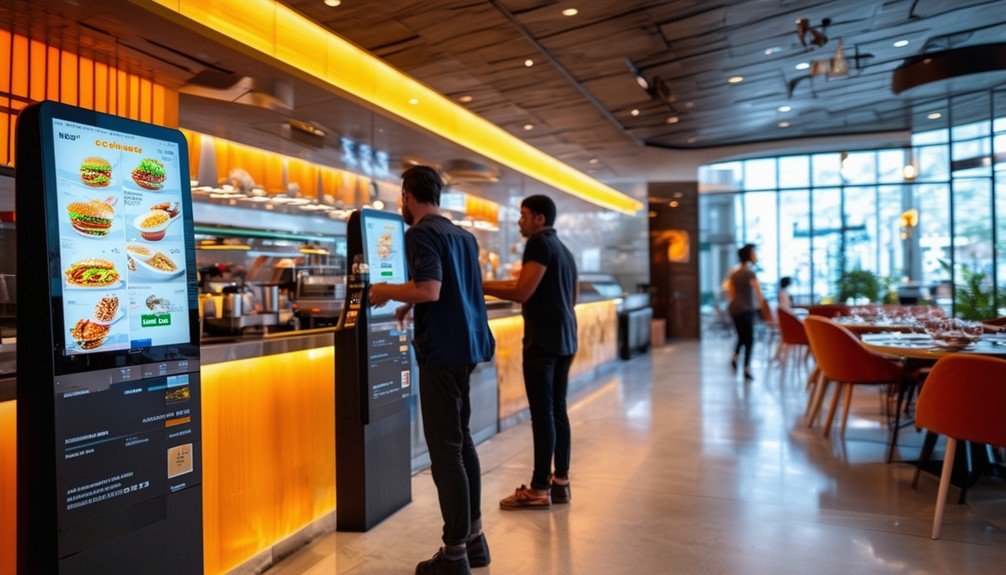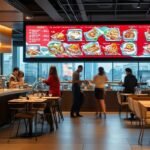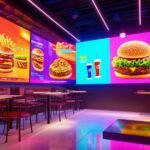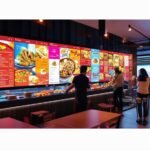Implementing self-service kiosks with digital signage can transform your restaurant’s efficiency and customer satisfaction. These kiosks streamline the ordering process, minimize wait times, and offer interactive menus for personalized orders. Digital signage dynamically updates menus and promotions, ensuring your offerings are always current and visually appealing. High-brightness displays and multilingual support cater to a diverse customer base, enhancing engagement. The integration with payment systems and real-time analytics further boosts operational efficiency and sales. Interested in seeing how these technologies reshape the fast-food industry and elevate customer experiences?
Key Takeaways
- Self-service kiosks with digital signage reduce wait times and streamline ordering.
- Interactive touch-screen interfaces enhance customer engagement and satisfaction.
- Dynamic content on digital signage promotes special offers and increases sales.
- Real-time menu updates ensure accurate, up-to-date offerings.
- Multilingual support on digital displays caters to a diverse customer base.
Whataburger Digital Kitchen Concept
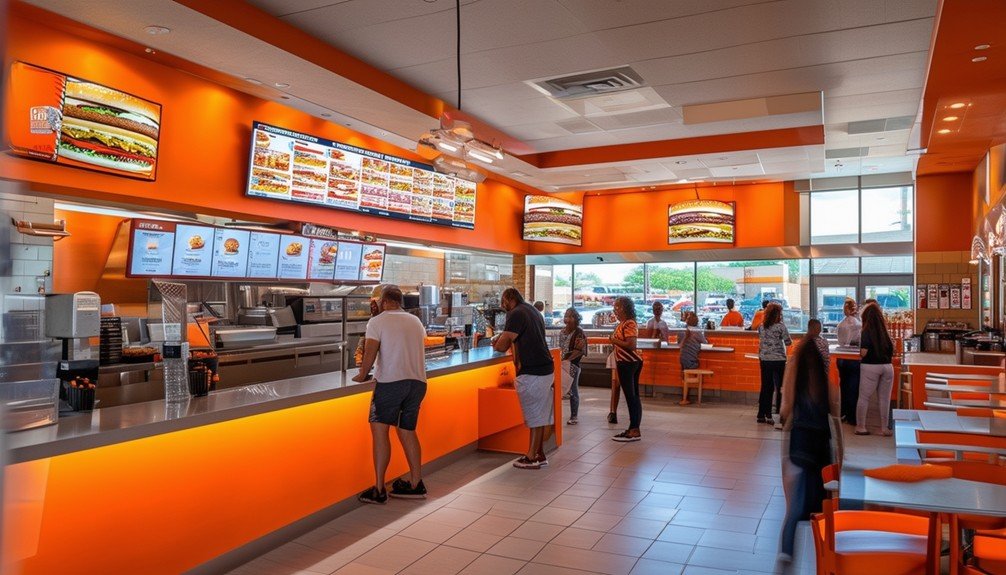
Whataburger’s introduction of a digital-only kitchen in Austin exemplifies a strategic shift towards cashless, app-based ordering systems, reflecting broader industry trends in fast-food service innovation. By leveraging digital signage, Whataburger enhances the user experience, providing a dynamic menu that’s not only visually appealing but also adaptable in real-time. This digital signage allows for rapid updates, ensuring that any changes in menu items, promotions, or pricing are instantly reflected, eliminating the inefficiencies of traditional static menus.
When you step into Whataburger’s Digital Kitchen, you interact with self-service kiosks that streamline the ordering process. These kiosks use touch-screen technology, linked directly to the central kitchen, capturing your order accurately and efficiently. The integration of real-time digital signage keeps you informed about your order status, promoting transparency and reducing wait times.
The exterior food lockers offer a seamless pickup experience. Once your order is ready, it’s placed in these secure lockers, and you receive a notification via the app. This method reduces human error and enhances food safety. By embracing these technologies, Whataburger’s Digital Kitchen sets a new standard for fast-food service, combining convenience with cutting-edge innovation.
Industry Adoption Trends
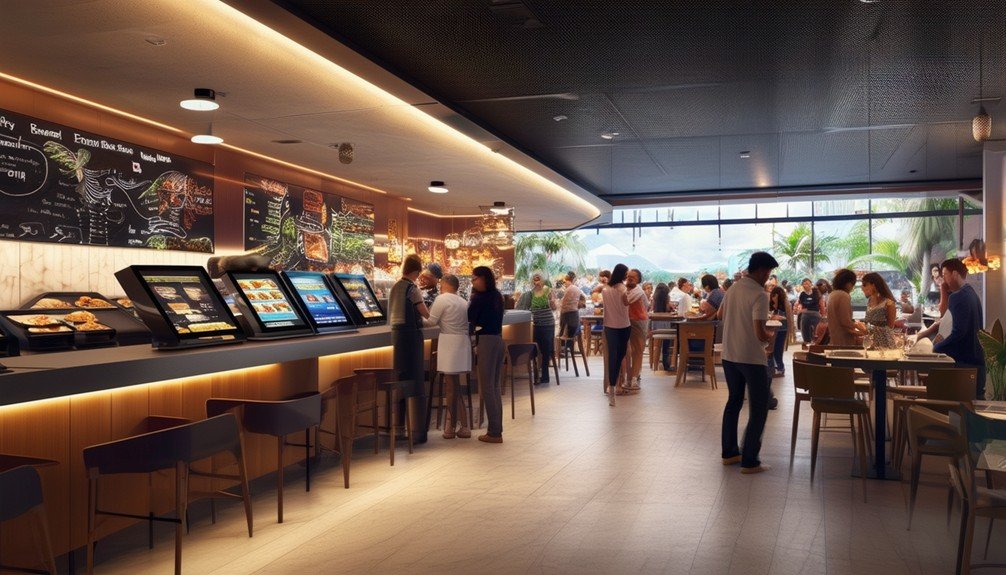
You’ll notice an increasing shift towards digital-only models among big names like Whataburger, Wingstop, Panera, and Dunkin Donuts. This trend not only boosts ordering efficiency but also meets the rising demand for off-premises dining. By leveraging self-service kiosks and apps, these restaurants are redefining customer experience and operational workflows.
Growing Digital-Only Models
The fast-food industry’s adoption of digital-only models is transforming customer interactions and operational efficiencies, driven by the increasing demand for off-premises dining solutions. In Austin, Whataburger’s digital-only restaurant exemplifies this trend with a streamlined setup that includes a mobile order lane and exterior food lockers for convenient pickups. Customers can utilize a digital menu and two self-service kiosks, enhancing the overall experience by reducing wait times and personalizing orders.
Other chains like Wingstop, Panera, and Dunkin Donuts are also embracing digital-only models, recognizing the shift in consumer preferences towards more efficient, tech-driven dining options. This move to digital kitchens represents a new era in fast-food service, focusing heavily on innovation and customer convenience.
Here’s a comparative look at some digital-only features:
| Restaurant | Location | Key Features | Customer Interactions |
|---|---|---|---|
| Whataburger | Austin | Digital menu, two self-service kiosks | Mobile order lane, food lockers |
| Wingstop | Various | Online ordering, digital payments | Contactless pickups |
| Panera | Nationwide | App-based orders, rapid pickup | Customized meal options |
| Dunkin Donuts | Multiple cities | Self-service kiosks, mobile orders | Quick service, minimal wait |
This shift underscores a broader industry trend towards leveraging technology to meet evolving customer demands, enhancing both convenience and efficiency.
Enhanced Ordering Efficiency
Leveraging digital ordering systems, fast-food chains are greatly enhancing operational efficiency and customer satisfaction by minimizing wait times and streamlining the ordering process. At Whataburger’s digital-only store in Austin, customers can now place orders through mobile apps, websites, or self-service kiosks. This shift reduces the traditional bottlenecks and speeds up service delivery. The digital-only concept aligns with the industry’s trend towards off-premises dining, reflecting changing consumer behaviors.
Digital kiosks facilitate a more efficient ordering process by offering a detailed display of menu items and promotions, managed through advanced content management systems. This results in dynamic and up-to-date menus that can be tailored to specific customer preferences or real-time inventory levels. Chains like Wingstop, Panera, and Dunkin Donuts are also adopting similar digital-only models, emphasizing the importance of seamless digital interactions in modern dining.
The use of exterior food lockers for order pickups at Whataburger exemplifies how digital innovation can enhance the customer experience. By integrating these technologies, fast-food chains are not only optimizing their operational workflows but are also meeting the growing demand for convenient, quick-service dining options. This trend is setting new industry standards for efficiency and customer satisfaction.
Key Features of Whataburger’s Model
You’ll find Whataburger’s model innovative with its mobile order lane and self-service kiosks enhancing customer convenience. The mobile order lane streamlines the pickup process, reducing wait times and improving order accuracy. Meanwhile, the self-service kiosks facilitate cashless transactions, aligning with the growing preference for digital interactions in dining experiences.
Mobile Order Lane
Integrating a mobile order lane into Whataburger’s digital kitchen concept in Austin revolutionizes the traditional drive-thru experience for enhanced efficiency and customer satisfaction. By allowing restaurants to streamline operations, this innovative approach reduces wait times and boosts order accuracy. Customers can place orders via the Whataburger website or app, creating a seamless and hassle-free experience. This model not only accelerates service but also strengthens marketing efforts by gathering valuable customer data, which can be leveraged for personalized promotions.
The mobile order lane is a significant upgrade from the conventional drive-thru system. It’s entirely cashless, promoting faster transactions and added convenience. This upgrade aligns with the broader trend of digital transformation within the food service industry, emphasizing speed and efficiency.
| Feature | Benefit |
|---|---|
| Mobile Ordering | Seamless customer experience |
| Cashless Transactions | Faster, more convenient service |
| Data Collection | Enhanced marketing efforts |
| Reduced Wait Times | Increased customer satisfaction |
Self-Service Kiosks
Whataburger’s self-help kiosks provide a streamlined and user-friendly interface, allowing customers to efficiently personalize and place their orders without waiting in line. These kiosks are part of Whataburger’s broader digital innovation strategy aimed at enhancing the overall customer experience. By integrating a touch-screen interface, the kiosks facilitate easy menu navigation, enabling you to customize your orders to your exact preferences. Whether you prefer extra pickles or no onions, the customization options are intuitive and all-encompassing.
The efficiency of these self-help kiosks is a key feature. They minimize traditional bottlenecks associated with counter service, notably reducing wait times. The kiosks also include payment functionalities, enabling you to complete your transaction seamlessly without any additional steps. This integrated approach not only speeds up the ordering process but also frees up staff to concentrate on food preparation and quality control.
Whataburger’s kiosks are designed to be accessible and user-friendly for all customers, featuring clear instructions and responsive touch screens. This guarantees a smooth and hassle-free experience, aligning with Whataburger’s commitment to customer satisfaction and operational effectiveness. Ultimately, these self-help kiosks embody a forward-thinking approach to fast-food service.
Enhancing Customer Experience
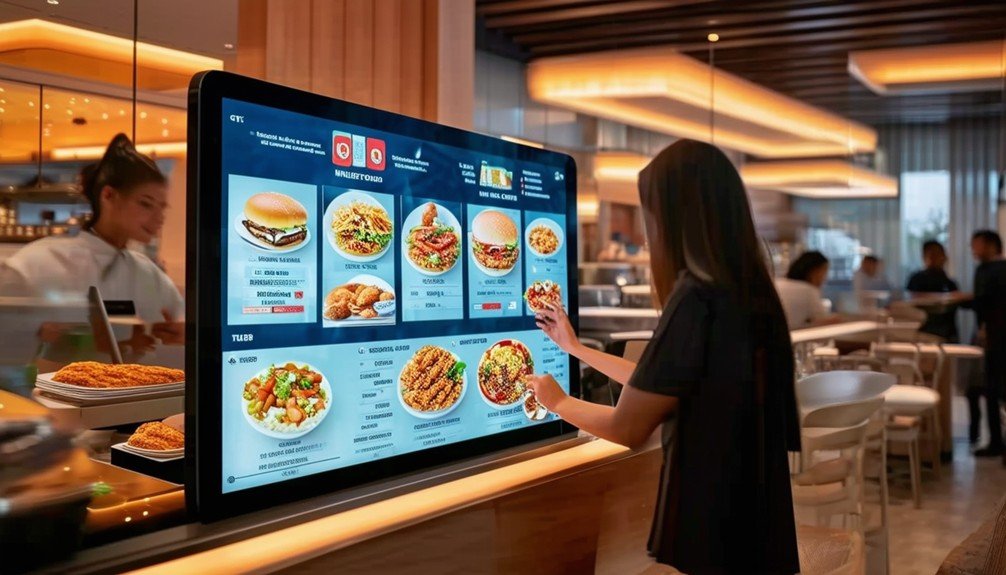
Digital signage in restaurant kiosks greatly enhances the customer experience by offering personalized ordering and dynamic menu customization. These high-brightness displays attract and engage you with vibrant graphics and video content, making the ordering process more enjoyable. Interactive features let you explore the menu in ways that traditional static displays can’t match, leading to increased satisfaction.
Here’s a quick look at the benefits:
| Feature | Benefit | Outcome |
|---|---|---|
| High-Brightness Displays | Engages Customers | Increased Visual Appeal |
| Interactive Menus | Personalized Ordering | Higher Customer Satisfaction |
| Dynamic Content | Promotes Special Offers | Boosts Impulse Purchases |
| Multilingual Displays | Tailored Experience | Wider Audience Reach |
Thanks to interactive menus, you can customize your orders, ensuring that your meal meets your exact preferences. Dynamic content keeps you informed about special offers and loyalty programs, often leading to spontaneous purchases. Additionally, the ability to switch languages on the fly means you can navigate the menu comfortably, no matter your language preference.
Impact on the Fast-Food Industry
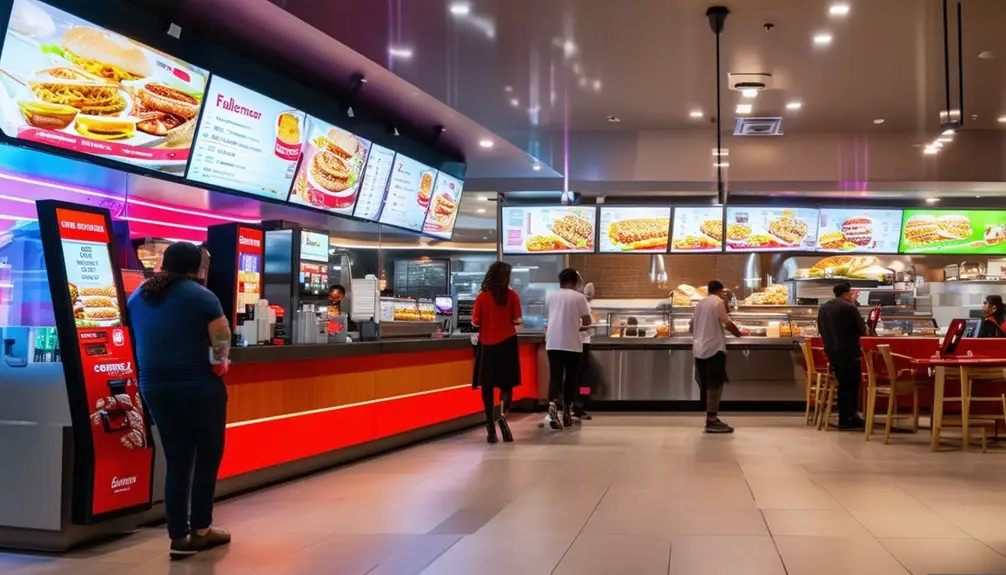
The rise of digital-only models in the fast-food industry signals a significant shift towards prioritizing convenience, speed, and digital integration to meet evolving consumer expectations. Companies like Whataburger, Wingstop, Panera, and Dunkin Donuts are leading this transformation. By adopting digital-only concepts, they cater to the growing demand for off-premises dining and seamless customer experiences.
Whataburger’s Digital Kitchen in Austin exemplifies this trend. It focuses on mobile order lanes, cashless transactions, and self-service kiosks, providing customers with a streamlined and efficient dining experience. Austin’s early digital adoption made it the ideal location for this innovative approach, setting Whataburger apart as a leader in digital restaurant experiences.
The fast-food industry is rapidly adapting to technological advancements to remain competitive. The shift towards digital-only models is not merely a trend but a strategic response to consumer preferences for faster service and minimal human interaction. Digital integration enhances operational efficiency, reduces wait times, and allows for personalized service through data analytics. These changes underscore a broader industry movement towards embracing technology to meet modern consumer needs, ensuring that fast-food chains remain relevant in a digital-first era.
Benefits of Digital Signage
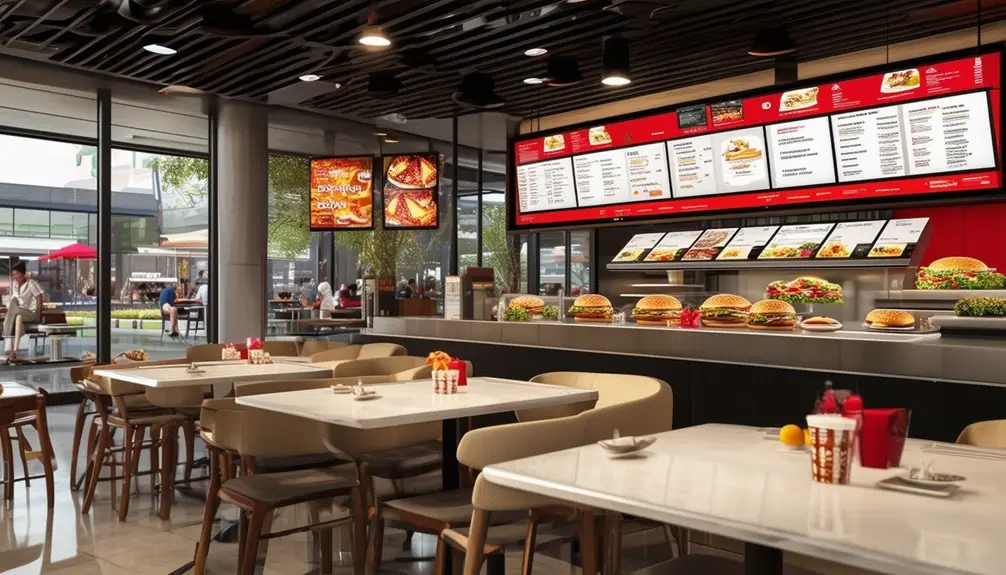
Implementing digital signage in your restaurant kiosks offers significant advantages by boosting sales and customer engagement, streamlining the order process, and enhancing menu flexibility. You can leverage dynamic content to capture attention and drive up to a 30% increase in sales, while also reducing perceived wait times. Additionally, digital menus allow for seamless updates, ensuring your offerings are always fresh and relevant.
Boosting Sales and Engagement
Harnessing the power of digital signage in your restaurant can greatly elevate both sales and customer engagement through high-brightness displays and dynamic content. These vivid, captivating screens can increase your sales by up to 30% by drawing customers in and keeping them engaged.
Digital signage offers a personalized experience by tailoring content to individual preferences and behaviors. Dynamic content, such as rotating specials and promotional videos, keeps the dining experience fresh and exciting. Additionally, interactive ordering options further enhance customer involvement, making them more likely to return.
Perceived wait times are notably reduced when engaging content distracts customers, making their overall experience more enjoyable. With the ability to easily update menus, you can swiftly adapt to seasonal changes or introduce new items without the hassle of reprinting. This flexibility supports upselling and cross-selling opportunities by highlighting high-margin items or complementary products.
Operational efficiency is another key benefit, as digital signage integrates seamlessly with payment systems and offers multilingual support, ensuring a smooth, inclusive experience for all patrons. By investing in digital signage, you’re setting the stage for a more engaging, profitable, and customer-centric restaurant environment.
Streamlining Order Process
Leveraging digital signage in restaurant kiosks not only boosts sales and engagement but also greatly streamlines the order process by enabling customers to place orders independently. You benefit from reduced wait times, making your operations more efficient and enhancing the overall dining experience. Self-service kiosks with digital signage allow customers to interact directly with the menu, which minimizes errors and speeds up the order-taking process.
Consider the following benefits:
| Benefit | Explanation | Impact |
|---|---|---|
| Reduced Wait Times | Customers order on their own | Faster service, higher turnover |
| Improved Efficiency | Streamlines operations | More orders processed in less time |
| Enhanced Customer Engagement | Interactive and intuitive interfaces | Higher satisfaction, repeat business |
| Upselling and Cross-Selling | Displays promotions and combos | Increased average order value |
| Reduced Staff Workload | Automation of ordering process | Staff focuses on other critical tasks |
Digital signage in kiosks not only improves the ordering process but also elevates customer engagement through interactive, easy-to-use interfaces. You’ll find that the technology enhances operational efficiency, resulting in faster service and happier customers. Additionally, by promoting specials and combo deals, digital signage can drive up your average order value, contributing to higher overall sales. Embracing this technology means your staff can focus on delivering exceptional service, rather than being bogged down by order taking.
Enhancing Menu Flexibility
Digital signage offers unparalleled menu flexibility, allowing you to make real-time updates that keep your offerings fresh and relevant throughout the day. This means you can instantly adjust your menu for breakfast, lunch, and dinner, or highlight daily specials and limited-time offers without the need for printing new materials. This agility not only streamlines your operations but also guarantees your customers are always informed about the latest and most exciting items on your menu.
Here’s how digital signage can enhance your menu flexibility:
- Dynamic Content: Use full-color graphics and videos to promote special offers and new menu items, engaging customers visually and encouraging them to try something new.
- Multilingual Displays: Cater to a diverse clientele by displaying your menu in multiple languages, ensuring every customer feels welcome and understood.
- Real-Time Updates: Quickly respond to inventory changes, seasonal ingredients, or customer preferences, making sure that your menu is always up-to-date and relevant.
Features of Self-Service Kiosks
Self-service kiosks in restaurants provide personalized menu options, streamline the ordering and payment process, and offer multilingual support to enhance both operational efficiency and the overall customer experience. By allowing customers to customize their orders, these kiosks reduce the likelihood of errors and increase customer satisfaction. The integration with payment systems guarantees a smooth transaction flow, reducing wait times and freeing up staff to focus on other tasks.
Multilingual support is essential in catering to a diverse customer base, making the dining experience inclusive and convenient. Additionally, self-service kiosks offer order tracking and status updates, providing transparency and reducing customer uncertainty. They effectively bridge the gap between front-end customer service and back-end operations, ensuring a cohesive dining experience.
Below is a table summarizing the key features and benefits of self-service kiosks:
| Feature | Benefit |
|---|---|
| Customizable Menus | Reduces order mistakes |
| Integrated Payment | Streamlines transaction process |
| Multilingual Support | Caters to a diverse customer base |
| Order Tracking | Enhances transparency and trust |
| Operational Efficiency | Frees staff for other essential tasks |
These features collectively contribute to a more efficient and satisfying dining experience, setting a new standard in restaurant service technology.
Importance of Content Management
Integrating effective content management into restaurant kiosks guarantees dynamic, real-time menu updates that cater to specific customer needs and improve operational efficiency. With a robust content management system, you can change menus on the fly, ensuring that every customer sees the most relevant and updated options.
Content management systems enable:
- Dynamic Menu Changes: Update your offerings instantly to reflect new dishes, sold-out items, or time-sensitive specials without the hassle of reprinting.
- Brand Consistency: Maintain a uniform brand image across multiple locations by centralizing control over the content displayed.
- Customer Engagement: Enhance the dining experience by showing promotions, upsell opportunities, and personalized recommendations.
Efficient content management is vital for scheduling menu variations throughout the day. It allows you to adapt breakfast, lunch, and dinner menus seamlessly, tailoring the offerings to the time of day and customer preferences. This flexibility not only improves customer satisfaction but also maximizes sales opportunities.
Digital signage supports easy updates, ensuring that the latest offerings and promotions are displayed accurately. This not only reduces the risk of miscommunication but also keeps the dining environment fresh and engaging. By integrating effective content management into your restaurant kiosks, you can greatly elevate the customer experience while streamlining operational processes.
Operational Efficiency and Cost Savings
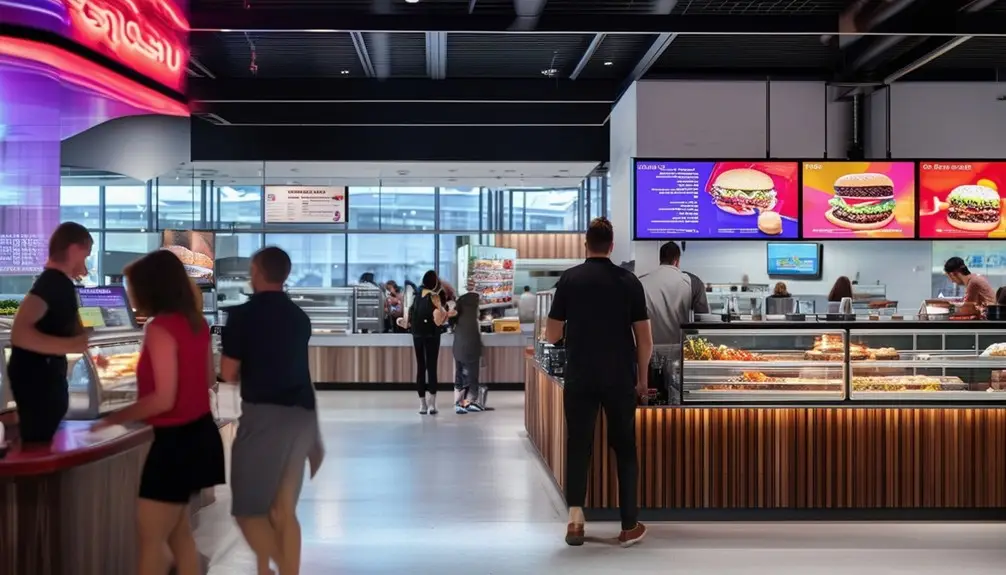
Leveraging digital signage in restaurant kiosks not just streamlines operations but also drives significant cost savings. With the integration of digital menus and remote content management, you can eliminate the need for constant printing. This reduction in printing costs directly impacts your bottom line. Additionally, digital signage can increase sales by up to 30%, enhancing your revenue potential.
Operational efficiency is heightened through seamless integration with POS systems. This integration allows for real-time updates and synchronization, ensuring that menu changes, promotions, and pricing adjustments are immediately reflected. Besides, digital kiosks help streamline order flow, reducing the workload on your staff. This not only improves service speed but also enhances overall profitability.
By utilizing real-time analytics, you can optimize promotions and menu placements based on customer behavior and sales data. These insights enable better decision-making and more effective use of promotional space, further driving sales and efficiency. Furthermore, reducing perceived wait times through engaging digital content can improve customer satisfaction and repeat business.
Incorporating digital signage in your restaurant kiosks is a strategic move that enhances operational efficiency and provides substantial cost savings, ultimately leading to a more profitable and streamlined business.
Marketing and Promotion Strategies
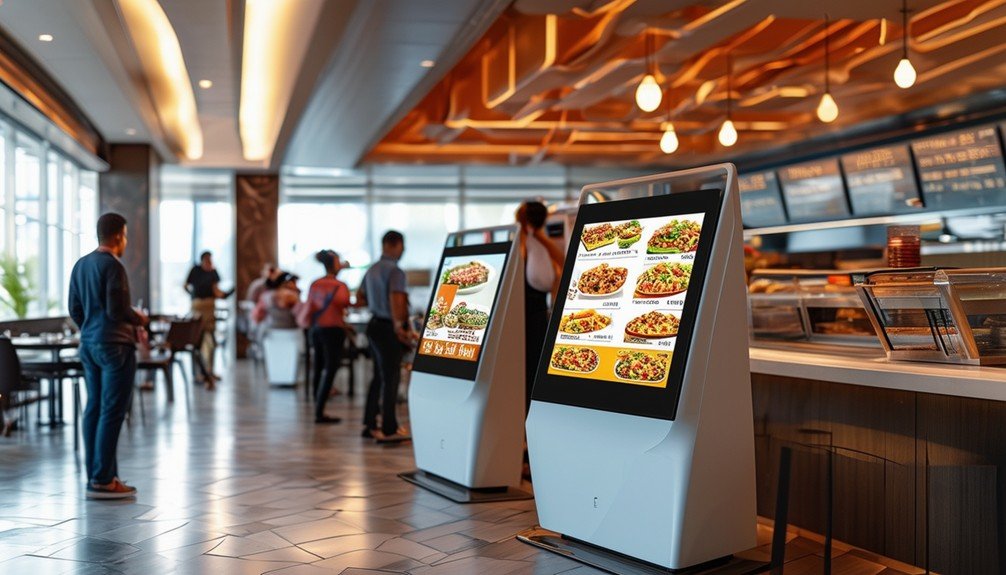
Effective marketing and promotion strategies for restaurant kiosks utilize the power of digital signage to captivate and engage customers both inside and outside the establishment. Outdoor LED displays and multiscreen setups are particularly effective for streetside marketing, drawing attention from passersby with vibrant full-color graphics and dynamic video content. High-brightness LCD displays in drive-thru lanes guarantee that promotional messages are clearly visible even in direct sunlight, influencing customer choices right before they place their orders.
By strategically utilizing digital signage, you can:
- Showcase limited-time offers and menu highlights: Use eye-catching visuals to promote quick menu items and special deals.
- Enhance curbside pickup experiences: Communicate efficiently with customers waiting outside, providing updates and engaging content.
- Integrate with restaurant management systems: Seamlessly update menus and promotions in real-time, ensuring consistency and relevance.
Window-based marketing strategies also play a significant role. Advanced digital signage technology can transform your windows into interactive displays, attracting potential customers even when your restaurant is closed. By managing these platforms effectively, you can guarantee that your marketing efforts are timely and targeted, ultimately driving higher foot traffic and increasing sales.
Conclusion
You’ve seen how Whataburger’s Digital Kitchen, combined with industry trends, enhances customer experience through advanced self-service kiosks. It’s clear that embracing such technology boosts operational efficiency and cuts costs. Plus, dynamic content management is key for effective marketing. Imagine stepping into a fast-food joint and feeling like you’re in a sci-fi movie—it’s that transformative. These innovations aren’t just trends; they’re the future of fast food, blending speed, satisfaction, and savvy marketing into one seamless experience.
Frequently Asked Questions
What Is the Difference Between Kiosk and Digital Signage?
The difference between kiosks and digital signage lies in functionality: kiosks let you interact and input orders via touchscreens, while digital signage displays dynamic content like promotions or menus, enhancing engagement without direct interaction.
How Do Digital Kiosks Work?
You interact with a touchscreen to place orders and customize meals. Your selections are sent digitally to the kitchen, minimizing errors. You can pay using various methods, browse menus, and get personalized recommendations, enhancing your dining experience.
What Is a Kiosk?
Imagine a digital concierge at your fingertips. A kiosk is a self-service station where you can independently place orders or access information. It’s designed for efficiency, often featuring touchscreens and interactive displays that streamline user interaction.

